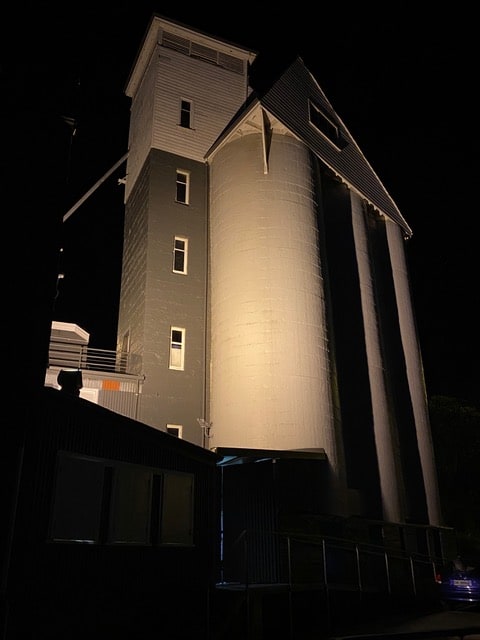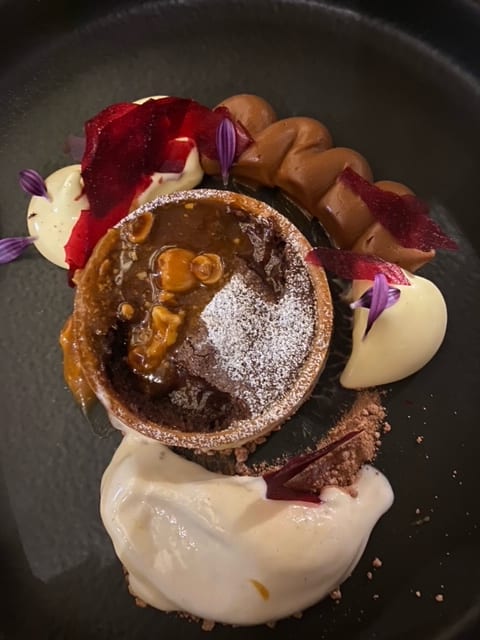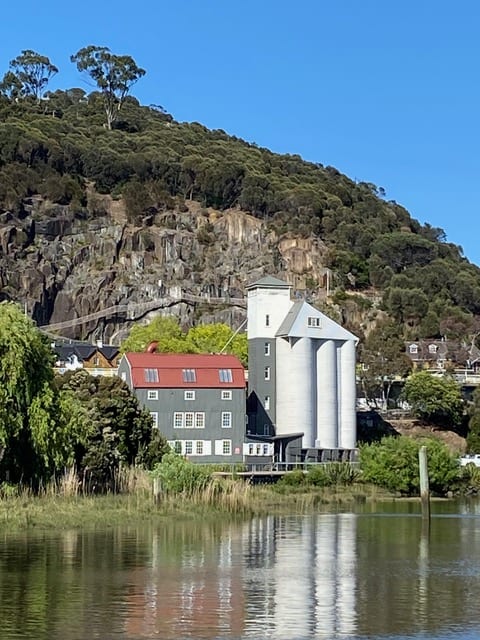There is nothing better than walking all day in the Tasmanian wilderness, breathing in that fresh divine air and marvelling at the mountains, then devouring a wholesome stew cooked on a gas stove, before sleeping cosily in a dome tent. Being in nature delivers inspiration and restores my soul. If the wilds are not available, however, the next-best way to get the most out of life is to experience eating and sleeping at one of the best places in town.
writer and photographer DON DEFENDERFER
Sparkling Tasmanian wine, exquisite Tasmanian food and sleeping in a loft next to an old mill by a river, and then listening in the morning to birds singing and a ferryboat hooting – to me this competes highly with camping.
The place journeyed to is set on the scenic edge of the banks of the confluence of the South Esk River and kanamaluka/Tamar River estuary in Launceston. It is called Stillwater. It may be Stillwater, by name and seem so on the surface, but it has a swift undertow of decadent and delicious pleasures that can quickly become seductively addictive.
To taste delicate fresh flavours, drink effervescent bubbly happiness and sleep upstairs in a room of absolute comfort overlooking the twinkling bobbing lights of boats on the river, I might even forgo a night or two in the dome. Might. That’s about as high a praise as I can muster for an alternative to camping.
Let me tell you more about the Stillwater experience.

If you dine or sleep at Stillwater, a must do is to walk across the street and into the Cataract Gorge Reserve and take in the beauty and history of the area. For tens of thousands of years, this was a sacred area for the regional aboriginal palawa community. It was known as a spiritual place where they gathered and carried out celebrations and ceremonies. The ancient spirits of the area can still be felt when you walk there, lurking in the shadows and in the guardian-like faces seen in the dolerite boulders and cliffs. (Guided walks by Aboriginal elders can be arranged so one can learn more about the history, geology and indigenous connections to the area).
A bit of the history of the area is worth noting and reading about when you are staying there as this history helps shape the Stillwater adventure.
In 1804 William Collins led a party of Europeans by boat into the South Esk, sailing past the site where Stillwater sits. Collins’s account of “the beauty of the scene ... probably not surpassed in the world”, is the earliest known record of European commentary on the area.
The beauty of the Stillwater area has not changed since the description by Collins.
Originally developed as a flourmill in 1833 by Andrew Sibbald and Thomas Ferguson, Stillwater’s infrastructure was an integral part of a water race that provided Launceston's principal fresh water supply until 1857. The area was considered Launceston’s El Dorado because of its fresh water source. Water was funnelled to the mill by wooden flumes that lined Cataract Gorge from a dam at the First Basin. This water also drove the mill stones. The water chutes can still be seen when you walk in The Gorge from Stillwater.
The mill was sold to David Ritchie in 1876. The wooden mill was replaced by concrete silos (which were then revolutionary in Tasmania) in about 1910 and milling flour and oats continued until 1943 when a fire destroyed the roof. The historic silos survived and remain.
The building continued to serve as a storage facility for a local grainery until 1973, after which it was revitalised and transformed into the Ritchies Mill Art Centre. The Millers Cottage was then developed into a café (Ripples) in 1984 by Rod Ascui. In 2000 the name was changed to Stillwater and today it is still known as an El Dorado for its world-class food, accommodation and views.

Welcome to Stillwater Seven! said the handwritten note lying on the locally made Waverley Mills throw blanket which sat artistically on the corner of a king-size bed. The room beckoned us in as we immediately noticed that it has a to die for view overlooking the harbor of the kanamaluka/Tamar River. A little table sat below the window with two wine glasses sitting there, waiting to be filled. It is our pleasure to have you sleep with us, resumed the flirty note. Enjoy!
And enjoy we did, every moment.
A glass of bubbly was delivered to us by the jovial hotelier co-owner Chris McNally (“Would you care for a complimentary glass of wine or perhaps a gin and tonic before dinner?”) as we sat by a set of old-fashioned paned windows and looked out to admire the sunny and seductive river view.
The sparkling cuvee (from the nearby Delamere vineyard) was a perfect way to start the evening and calm one’s soul.
Executive chef and co-owner Craig Will (who grew up in Launceston) later told me that Stillwater specialises in providing Tasmanian provincial wine and food at its finest. “We source as much local Tasmanian wine, produce, crafts and artwork as possible,” he said.
“I don’t think there is anything like the Tamar Valley anywhere in Australia. The area is abundant in vegetables, fruit, wine, seafood and meat. We are within arm’s reach of all the producers, and they are all friends of ours. A sense of community bond is really strong here.
“Because we are so small, we try to differentiate ourselves by being highly personal with all our customers and suppliers.
“Our friends come here to have a coffee – our goal for the restaurant is to make you feel comfortable and at home.”
“I love cooking. It’s fun. The best part of the job is on a busy night, working closely with the crew – I just want to cook the best possible food and have everyone enjoy it – guests and staff.
“Overall, we have 45 staff and we put a lot of effort into training and apprenticeships. It is a great career, but Tasmania has a shortage of cooks, so we work hard to inspire those we train so that they will stay in the industry forever.”
“Besides showcasing the best food and drink in the region, it is the location that makes Stillwater so special. Being right on the edge of the world-renowned Gorge and at the confluence of the Tamar and South Esk rivers – it doesn’t get much better than this.
“And it’s a great place to work too – when you are a bit busy, just to be able to look out the window on the river and boats and sun pouring in – that is immediately calming.
“This place really is special and unique when it comes to restaurant locations. We are lucky to be in this spot.”
We felt lucky to be there too as we finished our pre-dinner bubbles and watched the river waves and currents furl and unfurl

Promptly at seven, it was time for dinner, and this proved problematic: we wanted everything listed on the menu.
So, what to choose as a snack (the starter before the starters)? Tasmanian Tarkine oysters or gnocco fritto with Wagyu bresaola? Baby green lip abalone or southern rock lobster? And what entrée? Torched kingfish sashimi with bonito cream, verjuice ponzu, ruby grapefruit and sesame laver or warm beetroot tart? Cape Grim beef tartare or Rannoch Farm quail?
We chose the sashimi and the Cape Grim. To say it was delicious was an understatement. The subtle flavours were as intoxicating as the bubbly. We savoured each mouthful and I completely forgot how a stew tastes cooked on a Trangia by a tent in the rain. This food was taking me far away from the outdoors. The undertow of food and wine had captured me at Stillwater, and I was captive to its currents.
Main course was another impossible set of choices: Koji aged eye fillet, freekeh, beetroot and green beans or fresh Tasmanian yellowtail kingfish, squid ink rice, fennel foam, zucchini, lobster oil and rouille? Cressy lamb, smoked almond cream, vadouvan spiced lentils, eggplant pickle and season greens or Tasmanian wallaby, sake and mushroom, rainbow chard and adzuki beans?
We went for the lamb and the beef to support our local Tasmanian farmer friends. Superb. Delicate. Morish as the wine. Beyond comparison with any meat I have ever tasted. My Cradle Mountain stews will never taste the same again.
We sipped cabernet and sauvignon blanc wines (recommended by the cheerful and informed young waitress) as we slowly savoured the meal and became comfortably flush, enjoying the dizzying fluids.
The dessert choices were just as difficult and taxing a decision as the dinner options. We settled on dark chocolate fondant tart, hazelnut caramel, roasted milk chocolate cremeaux, with tonka bean ice cream and the coconut panna cotta, kiwifruit and vanilla, white chocolate coconut crumb and coconut sorbet. We would save the burnt honey and maple cream, pepperberry poached rhubarb and the torched marshmallow meringue, pear and lemon verbena and yuzu ice cream for next time.
Life is worth living, if only for the next dessert at Stillwater.
We slept like peas in a floating pod, drifting off dizzily to the sound of the South Esk slithering down from the Gorge and quiet waves slopping the shores of kanamaluka.
. . .
The Stillwater rooms face east, and the morning sun came into our room, cheerfully welcoming us to a new day. Gulls were gulling outside, a ferry was tooting, the sun was rising, early morning joggers were running past and all of life seemed good.
We dialled a number and soon a fresh St Ali Orthodox blend coffee was delivered to our room. We sipped the fine cappuccino, looked out on the view and enjoyed the in-house breakfast. Just a normal camping breakfast: chia pudding, fresh fruit, roasted almond butter, creamy yogurt and berries, a bread and butter baguette and warm croissant and leatherwood honey.
Late in the morning we re-joined the civilians of normal life. Somehow, we escaped the undertow of Stillwater and found a shore of reality to resume our secular lives.
My only complaint about the whole experience was that we had to stop drinking and eating and sleeping and check out. But we vowed to come again, and this gave us heart and inspiration about Tasmania and what people dedicated to a philosophy of fine service, quality local food and drink can do. Tasmania is second to none in the world on the gastronomic experiences it can provide.
My soul was restored and inspired by the Stillwater experience, just like a renewing hike in the wilderness can do. But for this adventure I didn’t have to carry a pack and the adventure was immensely rewarding. We shall hike to and camp at Stillwater again.
Don Defenderfer and his wife, Rowena Bell, were the guests of Stillwater.
Don Defenderfer is a native of San Francisco who once went on a holiday to Alaska where he met an Australian who told him to visit Tasmania. So he did, and while here he met a woman. That was 40 years ago. He was state coordinator for Landcare for many years, a job that allowed him to be inspired by not only the beauty of the Tasmanian landscape but by the many people that are trying to repair and renew it. He has a Masters Degree in Social Ecology and a Bachelor of Environmental Studies with a minor in writing. He has published three volumes of poetry, and his work has appeared in newspapers and periodicals, including The New York Times and The Australian. Two volumes of collected essays and poems, "Tasmania: An island dream" Parts 1 and 2, can be bought through the Forty South Bookshop.










